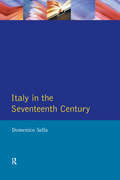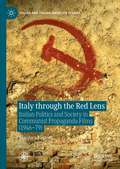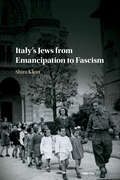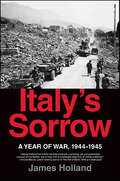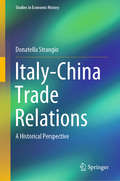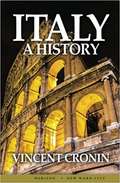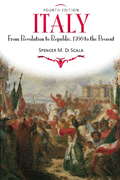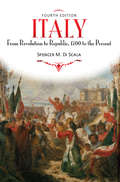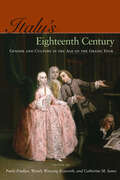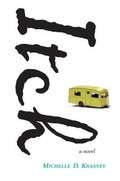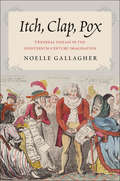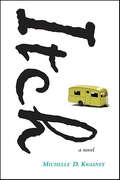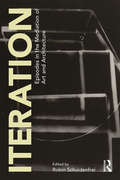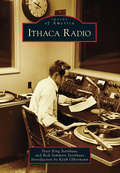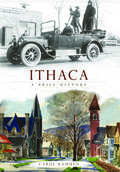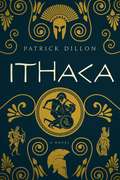- Table View
- List View
Italy in the International System from Détente to the End of the Cold War
by Benedetto Zaccaria Antonio VarsoriThis edited collection offers a new approach to the study of Italy’s foreign policy from the 1960s to the end of the Cold War, highlighting its complex and sometimes ambiguous goals, due to the intricacies of its internal system and delicate position in the fault line of the East-West and North-South divides. According to received opinion, during the Cold War era Italy was more an object rather than a factor in active foreign policy, limiting itself to paying lip service to the Western alliance and the European integration process, without any pretension to exerting a substantial international influence. Eleven contributions by leading Italian historians reappraise Italy’s international role, addressing three complex and intertwined issues, namely, the country’s political-diplomatic dimension; the economic factors affecting Rome’s international stance; and Italy’s role in new approaches to the international system and the influence of political parties’ cultures in the nation’s foreign policy.
Italy in the New International Order, 1917–1922 (Security, Conflict and Cooperation in the Contemporary World)
by Benedetto Zaccaria Antonio VarsoriThis edited collection offers the first systematic account in English of Italy’s international position from Caporetto – a major turning-point in Italy’s participation in the First World War – to the end of the liberal regime in Italy in 1922. It shows that after the ‘Great War’, not only did Italy establish itself as a regional power but also achieved its post-unification ambition to be recognised, at least from a formal viewpoint, as a great power. This subject is addressed through multiple perspectives, covering Italy’s relations and mutual perceptions vis-à-vis the Allies, the vanquished nations, and the ‘New Europe’. Fourteen contributions by leading historians reappraise Italy’s role in the construction of the post-war international order, drawing on extensive multi-archival and multi-national research, combining for the first time documents from American, Austrian, British, French, German, Italian, Russian and former Yugoslav archives.
Italy in the Seventeenth Century (Longman History of Italy)
by Domenico SellaIn his comprehensive overview of 17th century Italy, Professor Sella challenges the old view that Italy was in general decline, instead he shows it to have been a time of sharp contrasts and shifts in fortune. He starts with a balanced and critical analysis of political developments (placing the Italian states in their wider European context) before assessing the state of the economy. He then looks in depth at society, religion, and culture and science and in particular reassesses the influence of the Counter Reformation on Italian life. His book ends with an engrossing account of the life and work of Galileo as well as an overview of the important and often neglected contributions made by other scientists in the later part of the century. This rich and balanced volume is an ideal introduction to early modern Italy, and provides a critical revaluation of a much misunderstood period in the country's history.
Italy on the Pacific: San Francisco's Italian Americans (Italian and Italian American Studies)
by Sebastian FicheraThis book details the Italian immigrant experience in San Francisco from the Gold Rush to the Mayoralty of George Moscone - which is to say the entire life cycle of the Italian community - and defines the concept of community in a way never seen before.
Italy through the Red Lens: Italian Politics and Society in Communist Propaganda Films (1946–79) (Italian and Italian American Studies)
by Gianluca FantoniThis book offers the first comprehensive analysis of the role of cinema in the communication strategy of the Italian Communist party (the PCI). It examines the entire period during which the party had a systematic and organized approach to cinematographic production, starting with the early experiments in 1946 and concluding with the closure of PCI film company Unitelefilm at the end of the 1970s. Its analysis sheds light on a range of issues, such as the relationship between the party and Italian intellectuals, the Stalinist imprint of the Italian Communist Party and the historical significance of the Salerno turn, the PCI’s relationship with the student movements in 1968 and 1977, and the PCI’s response to the rise in political violence in the 1970s. Ultimately, the book demonstrates that cinema was essential to the PCI’s propaganda effort.
Italy's Jews from Emancipation to Fascism
by Shira KleinHow did Italy treat Jews during World War II? Historians have shown beyond doubt that many Italians were complicit in the Holocaust, yet Italy is still known as the Axis state that helped Jews. Shira Klein uncovers how Italian Jews, though victims of Italian persecution, promoted the view that Fascist Italy was categorically good to them. She shows how the Jews' experience in the decades before World War II - during which they became fervent Italian patriots while maintaining their distinctive Jewish culture - led them later to bolster the myth of Italy's wartime innocence in the Fascist racial campaign. Italy's Jews experienced a century of dramatic changes, from emancipation in 1848, to the 1938 Racial Laws, wartime refuge in America and Palestine, and the rehabilitation of Holocaust survivors. This cultural and social history draws on a wealth of unexplored sources, including original interviews and unpublished memoirs.
Italy's Sorrow: A Year of War, 1944-1945
by James HollandIn a chilling history, renowned historian James Holland deftly relates Italy's dark forgotten years During the Second World War, the campaign in Italy was the most destructive fought in Europe - a long, bitter and highly attritional conflict that raged up the country's mountainous leg. For frontline troops, casualty rates at Cassino and along the notorious Gothic Line were as high as they had been on the Western Front in the First World War. There were further similarities too: blasted landscapes, rain and mud, and months on end with the front line barely moving. And while the Allies and Germans were fighting it out through the mountains, the Italians were engaging in bitter battles too. Partisans were carrying out a crippling resistance campaign against the German troops but also battling the Fascists forces as well in what soon became a bloody civil war. Around them, innocent civilians tried to live through the carnage, terror and anarchy, while in the wake of the Allied advance, horrific numbers of impoverished and starving people were left to pick their way through the ruins of their homes and country. In the German-occupied north, there were more than 700 civilian massacres by German and Fascist troops in retaliation for Partisan activities, while in the south, many found themselves forced into making terrible and heart-rending decisions in order to survive.Although known as a land of beauty and for the richness of its culture, Italy's suffering in 1944-1945 is now largely forgotten. Italy's Sorrow by James Holland is the first account of the conflict there to tell the story from all sides and to include the experiences of soldiers and civilians alike. Offering extensive original research, it weaves together the drama and tragedy of that terrible year, including new perspectives and material on some of the most debated episodes to have emerged from World War II.
Italy, Yugoslavia, and the Controversy over the Adriatic Region, 1915-1920: Strategic Expectations and Geopolitical Realities in the Aftermath of the Great War (Routledge Studies in the History of Russia and Eastern Europe)
by Bianchini, Edited by StefanoThis book explores the path that led to the Treaty of Rapallo (1920) between Italy and the new Kingdom of the Serbs, Croats and Slovenes, later the Kingdom of Yugoslavia, in the aftermath of the First World War, when the territories of the former Austro-Hungarian Empire were allotted to new and existing states, with regard as far as possible to the nationalities of the people living in the various territories in addition to the future of Montenegro and Albania.Based on vast archival documentation and published sources, the contributors to this book discuss the nature of the disputes which arose in the Adriatic area, often as the result of the inhabitants of the different territories being of several nationalities, and examine how the disputes were concluded. The book charts the disappointments of both Italians and Yugoslavs, the Italians disappointed that the terms of the Treaty of London of 1915, which promised Dalmatia to Italy in return for Italy entering the war against the Austro-Hungarian Empire, were not fulfilled. The Yugoslavs were disappointed loosing territories containing large Yugoslav populations. The volume considers public opinion, the words, positions and actions of leading politicians, and the continuing consequences of the settlement, many of them adverse consequences for particular cities and localities.Presenting a comprehensive approach to the Adriatic controversy, this book will be of interest to those studying European history of international relations, diplomatic negotiations and nationalism, modern history, Central Asian, Eastern European and Russian Studies.
Italy-China Trade Relations: A Historical Perspective (Studies in Economic History)
by Donatella StrangioThis book examines the political connections and trade relations between Italy and China, with particular emphasis on the second half of the 19th century and the period following the Second World War. In recent years, economic relations between the two countries have intensified as a result of increasing exchange and trade agreements, with positive impacts on their political and diplomatic relations. By studying original public sources such as the Archives of the Italian Ministry of Foreign Affairs, the Bank of Italy and the Central State Archives in Rome, the author offers a historical perspective on the evolution of the two countries’ economic and political ties. The respective chapters address e.g. the role of international governmental authorities, the role of the Italian Bank of China, the impact of trade agreements and foreign investment projects, etc. Given its scope, the book will appeal to scholars of economic history and international economics, as well as political scientists and legal scholars with an interest in international diplomacy and trade agreements.
Italy: A History
by Vincent CroninHere, from New York Times bestselling historian Vincent Cronin, is the extraordinary story of Italy - from the birth of the Roman Empire to the rise of the city-states through the Renaissance and the making of modern Italy.
Italy: A Short History
by Harry HearderIntended for the student of Italian history and culture as well as the general reader, this new edition presents a clear and concise account of the principal developments in Italian history from the Ice Age to the present day. Dr. Jonathan Morris has updated the late Professor Hearder's long-established and highly successful work with an authoritative account of development in Italy over the past decade.
Italy: From Revolution to Republic, 1700 to the Present (4th edition)
by Spencer DiscalaThis essential book fills a serious gap in the field by synthesizing modern Italian history and placing it in a fully European context. Emphasizing globalization, Italy traces the country’s transformation from a land of emigration to one of immigration and its growing cultural importance. Including coverage of the April 2008 elections, this updated edition offers expanded examinations of contemporary Italy’s economic, social, and cultural development, a deepened discussion on immigration, and four new biographical sketches. Author Spencer M. Di Scala discusses the role of women, gives ample attention to the Italian South, and provides a picture of how ordinary Italians live. Cast in a clear and lively style that will appeal to readers, this comprehensive account is an indispensable addition to the field.
Italy: From Revolution to Republic, 1700 to the Present, Fourth Edition (Makers Of The Modern World Ser.)
by Spencer M. DiScalaThis essential book fills a serious gap in the field by synthesizing modern Italian history and placing it in a fully European context. Emphasizing globalization, Italy traces the country?s transformation from a land of emigration to one of immigration and its growing cultural importance. Including coverage of the April 2008 elections, this updated edition offers expanded examinations of contemporary Italy?s economic, social, and cultural development, a deepened discussion on immigration, and four new biographical sketches. Author Spencer M. Di Scala discusses the role of women, gives ample attention to the Italian South, and provides a picture of how ordinary Italians live. Cast in a clear and lively style that will appeal to readers, this comprehensive account is an indispensable addition to the field.
Italy’s Eighteenth Century: Gender and Culture in the Age of the Grand Tour
by Paula Findlen Catherine Sama Wendy Wassyng RoworthIn the age of the Grand Tour, foreigners flocked to Italy to gawk at its ruins and paintings, enjoy its salons and cafés, attend the opera, and revel in their own discovery of its past. But they also marveled at the people they saw, both male and female. In an era in which castrati were "rock stars," men served women as cicisbei, and dandified Englishmen became macaroni, Italy was perceived to be a place where men became women. The great publicity surrounding female poets, journalists, artists, anatomists, and scientists, and the visible roles for such women in salons, academies, and universities in many Italian cities also made visitors wonder whether women had become men. Such images, of course, were stereotypes, but they were nonetheless grounded in a reality that was unique to the Italian peninsula. This volume illuminates the social and cultural landscape of eighteenth-century Italy by exploring how questions of gender in music, art, literature, science, and medicine shaped perceptions of Italy in the age of the Grand Tour.
Itch
by Michelle D. KwasneyAfter the death of her beloved Gramps, Delores Colchester, better known as "Itch", moves with her grandmother from Florida to Ohio. Starting over is hard, and Itch feels like an outsider in her new school, until she becomes friends with popular baton-twirling Gwendolyn. On the outside, Gwendolyn seems perfect: talented, smart, and beautiful. But she has a dark secret, which Itch begins to suspect and soon discovers is true. "Speaking up takes courage", Gramps had always told Itch, and she's about to discover just how much. Michelle D. Kwasney weaves a compelling story about child abuse, family, and friendship against the backdrop of the late 1960s.
Itch, Clap, Pox: Venereal Disease in the Eighteenth-Century Imagination
by Noelle GallagherA lively interdisciplinary study of how venereal disease was represented in eighteenth-century British literature and art In eighteenth-century Britain, venereal disease was everywhere and nowhere: while physicians and commentators believed the condition to be widespread, it remained shrouded in secrecy, and was often represented using slang, symbolism, and wordplay. In this book, literary critic Noelle Gallagher explores the cultural significance of the “clap” (gonorrhea), the “pox” (syphilis), and the “itch” (genital scabies) for the development of eighteenth-century British literature and art. As a condition both represented through metaphors and used as a metaphor, venereal disease provided a vehicle for the discussion of cultural anxieties about gender, race, commerce, and immigration. Gallagher highlights four key concepts associated with venereal disease, demonstrating how infection’s symbolic potency was enhanced by its links to elite masculinity, prostitution, foreignness, and facial deformities. Casting light where the sun rarely shines, this study will fascinate anyone interested in the history of literature, art, medicine, and sexuality.
Itch: A Novel
by Michelle D. KwasneyAfter the death of her beloved Gramps, Delores Colchester, better known as "Itch," moves with her grandmother from Florida to Ohio. Starting over is hard, and Itch feels like an outsider in her new school, until she becomes friends with popular baton-twirling Gwendolyn. On the outside, Gwendolyn seems perfect: talented, smart, and beautiful. But she has a dark secret, which Itch begins to suspect and soon discovers is true. "Speaking up takes courage," Gramps had always told Itch, and she's about to discover just how much. Michelle D. Kwasney weaves a compelling story about child abuse, family, and friendship against the backdrop of the late 1960s.Itch is a 2009 Bank Street - Best Children's Book of the Year.
Iteration: Episodes in the Mediation of Art and Architecture
by Robin SchuldenfreiThis edited volume considers the ways in which multiple stages, phases, or periods in an artistic or design process have served to arrive at the final artifact, with a focus on the meaning and use of the iteration. To contextualize iteration within artistic and architectural production, this collection of essays presents a range of close studies in art, architectural and design history, using archival and historiographical research, media theory, photography, material studies, and critical theory. It examines objects as unique yet mutable works by examining their antecedents, successive exemplars, and their afterlives—and thus their role as organizers or repositories of meaning. Key are the roles of writing, the use of media, and relationships between object, image, and reproduction. This volume asks how a closer look at iteration reveals new perspectives into the production of objects and the production of thought alike. Written by an international team of contributors, offering a range of perspectives, it looks broadly at meaning and insight offered by the iteration—for processes of design, for historical research, and for the reception of creative works.
Ithaca (Songs of Penelope #1)
by Claire NorthFrom the multi-award-winning author Claire North comes a daring reimagining that breathes life into ancient myth and gives voice to the women who stand defiant in a world ruled by ruthless men. It&’s time for the women of Ithaca to tell their tale . . ."North brings a powerful, fresh, and unflinching voice to ancient myth. Breathtaking." —Jennifer Saint, author of Ariadne Seventeen years ago, King Odysseus sailed to war with Troy, taking with him every man of fighting age from the island of Ithaca. None of them has returned, and the women of Ithaca have been left behind to run the kingdom. Penelope was barely into womanhood when she wed Odysseus. While he lived, her position was secure. But now, years on, speculation is mounting that her husband is dead, and suitors are beginning to knock at her door. No one man is strong enough to claim Odysseus' empty throne—not yet. But as everyone waits for the balance of power to tip, Penelope knows that any choice she makes could plunge Ithaca into bloody civil war. This is the story of Penelope of Ithaca, famed wife of Odysseus, as it has never been told before. Beyond Ithaca's shores, the whims of gods dictate the wars of men. But on the isle, it is the choices of the abandoned women—and their goddesses—that will change the course of the world.
Ithaca Forever: Penelope Speaks, A Novel
by Luigi MalerbaAfter twenty years, Odysseus finally returns to Ithaca, but instead of receiving the homecoming he had hoped for finds himself caught in an intense battle of wills with his faithful and long-suffering wife Penelope. When Penelope recognizes him under the guise of a beggar, she becomes furious with him for not trusting her enough to include her in his plans for ridding the palace of the Suitors. As a result, she plays her own game of fictions to make him suffer for this lack of faith, inspiring jealousy, self-doubt, and misgivings in her husband, the legendary Homeric hero. In this captivating retelling of the Odyssey, Penelope rises as a major force with whom to be reckoned. Shifting between first-person reflections, Ithaca Forever reveals the deeply personal and powerful perspectives of both wife and husband as they struggle for respect and supremacy within a marriage that has been on hold for twenty years. Translated by PEN award-winner Douglas Grant Heise, Luigi Malerba’s novel gives us a remarkable version of this greatest work of western literature: Odysseus as a man full of doubts and Penelope as a woman of great depth and strength.
Ithaca Radio
by Keith Olbermann Rick Sommers Steinhaus Peter King SteinhausFrom Long Island to Fiji, college students flocked to the sleepy little town of Ithaca to learn the how-tos and how-not-tos of broadcasting. From that influx came some of the future leaders and celebrities of the broadcasting industry. Television stars were born here, and some of radio's future stars were nurtured to succeed in an industry that impacts the daily lives of Americans. Ithaca's rich broadcasting history includes two college radio stations and several locally owned and operated stations. From the Greaseman to Keith Olbermann, Ithaca was the launch pad for numerous successful careers in music, talk, news, business, and satellite radio. Through vintage photographs, Ithaca Radio shares a history of local radio and some of the great voices that have called Ithaca home.
Ithaca: A Brief History
by Carol KammenCalmly nestled among the glacial streams and hills of central New York, residents of Ithaca may find it hard to believe that their city began with a rocky start. Transient teamsters and salt barge workers gave the town a rowdy reputation in its pioneer days, and the fledgling village seemed doomed as the "most isolated place on the Eastern Seaboard." Over the course of the nineteenth century, Ithaca's character swung like a pendulumfrom debauchery to temperance, from boisterous vagrancy to religious fervor and reform. Though the town was hit hard by the Depression of 1837 and periodically ravaged by fire and flood, Ithaca survived to become a lively and bustling community and an important center of education, technologicalinnovation and cultural vibrancy. In this comprehensive history, Carol Kammen shows exactly why Ithaca is known as the "Crown of Cayuga."
Ithaca: A Novel of Homer's Odyssey
by Patrick DillonIn the tumultuous aftermath of the Trojan War, a young man battles to save his home and his inheritance. Setting out to find his father, he ends up discovering himself. Telemachus’s father, Odysseus, went off to war before he was born … and never came back. Aged sixteen, Telemachus finds himself abandoned, his father’s house overrun with men pursuing his beautiful mother, Penelope, and devouring the family’s wealth. He determines to leave Ithaca, his island home, and find the truth. What really happened to his father? Was Odysseus killed on his journey home from the war? Or might he, one day, return to take his revenge? Telemachus's journey takes him across the landscape of bronze-age Greece in the aftermath of the great Trojan war. Veterans hide out in the hills. Chieftains, scarred by war, hoard their treasure in luxurious palaces. Ithaca re-tells Homer’s famous poem, The Odyssey, from the point of view of Odysseus’ resourceful and troubled son, describing Odysseus’s extraordinary voyage from Troy to the gates of hell, and Telemachus’s own journey from boyhood to the desperate struggle that wins back his home … and his father.
Itihas (C. 750-1206) BA (Hons) Sem-III -Ranchi University, N.P.U
by A. K. MittalItihas (C. 750-1206) Core Course-C 5 and Core Course-C 6 text book According to the Latest Syllabus based on Choice Based Credit System (CBCS) for B.A (Hons.) Sem-II from Ranchi University, Nilambar Pitambar University in hindi.
Itihas Aur Nagrik Shastra class 6 - Maharashtra Board: इतिहास और नागरिक शास्त्र ६वीं कक्षा - महाराष्ट्र बोर्ड
by Maharashtra Rajya Pathyapustak Nirmiti Va Abhysakram Sanshodhan Mandal Puneयह पुस्तक "इतिहास और नागरिकशास्त्र" छठी कक्षा की पाठ्यपुस्तक है, जिसमें भारत के संविधान, इतिहास, नागरिकशास्त्र, प्राचीन भारत की संस्कृति, शासन व्यवस्था आदि विषयों पर जानकारी दी गई है। यह पुस्तक छठी कक्षा के विद्यार्थियों के लिए इतिहास और नागरिकशास्त्र विषयों को एक समग्र रूप में प्रस्तुत करती है। इसमें प्राचीन भारत के इतिहास का वर्णन है, जिसमें हड़प्पा संस्कृति, वैदिक संस्कृति, जनपद और महाजनपद, मौर्यकालीन भारत आदि शामिल हैं। इसके साथ ही, नागरिकशास्त्र के अंतर्गत संविधान, नागरिक अधिकार और कर्तव्य, स्थानीय शासन संस्थाएँ और समाज में विविधता पर प्रकाश डाला गया है। पुस्तक का उद्देश्य विद्यार्थियों को भारतीय इतिहास और नागरिकशास्त्र की मूलभूत जानकारी देना है ताकि वे अपनी सांस्कृतिक और सामाजिक पहचान को समझ सकें तथा एक जिम्मेदार नागरिक बन सकें।


